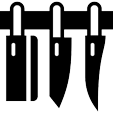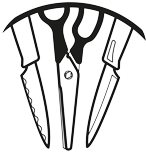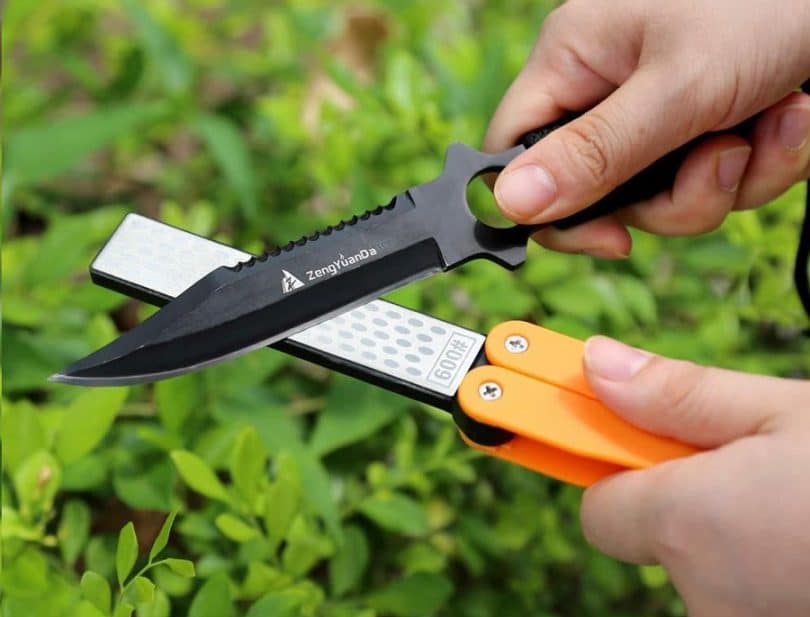Survival knives are indispensible for an adventurer, whether you are hunting or camping. As the owner of a stylish survival knife, keeping them in top shape should be a priority. One of the best ways to keep your knives ready for action is to sharpen them regularly and ensure that their edges are sturdy and razor sharp and for this, you will need a sharpening stone. Fortunately, there are many types of sharpening stone tools you can choose from.
- Sharpening stones
Sharpening stones are common tools used alongside survival knives, ideal for honing or grinding the edges of stainless steel blades as well as other tools. These stones can be found in many sizes, materials, shapes etc and can be either flat edged or more complex in shape. Sharpening stones for knives are commonly classified on grits that is directly related to the finesse of the edge on the blade surface. Stones with finer grits remove less material at a time and therefore cut slower. The term grit is represented through a number that normally indicates the particle density of the stones. Higher the grit number, higher the density.
- Diamond sharpeners
Diamond sharpening stones are made from a composite base or metal and surfaced with micron diamonds bonded securely on the top layer. This is achieved through a nickel plating process. Compared to other sharpening stones, diamond sharpeners are faster and more effective. Available in multiple grits, these sharpeners can be used wet or dry. At KnifeIndia, we recommend you to use diamond sharpeners when wet as it protects the diamond lining from abrasions. To maintain diamond sharpeners, use mineral oil or water for lubrication and clean the surface thoroughly before the next use.
- Sharpening steels
Sharpening steels were initially designed as rods and were made harder than the blade to be effective. However, they are mainly useful to correct alignment of the blade and light honing. Some sharpening steels are available with a diamond coating that dramatically improve the grinding process and can also be replaced with ceramic coating. Like other metal and natural stone sharpeners, steel tools can be used both wet and dry.
- Natural sharpening stones
Natural sharpening stones are normally comprised of high grade silica and occur in different grits, depending on the individual stone. What makes these stones interesting is that they are self-renewing and are known for their abrasive qualities. Silica stones are structured with a honeycomb like construction or similar to stacked bubbles. When you use this stone on a knife, all you are doing is scrapping away the top later of bubbles and exposing a fresh unused layer. This very structure of natural sharpening stones is their drawback as they eventually become hollow and brittle.
Similar to diamond sharpeners, natural stones can be used in wet and dry conditions with very little
- Electric knife sharpeners
Electric knife sharpeners are popular choices today and usually come in boxes with a few slots for blades. Once you place the blade in the slot, a motor powered wheel spins and sharpens the blade, which you have to pull and push for even grinding. While these knives are quick, convenient and easy to use, they give less control to the user in comparison to manual hand sharpening stones. Electric knife sharpeners are also limited when it comes to sharpening the whole blade’s edge and can be quite difficult to carry around.
- Sharpening fluid
Sharpening fluid is an important accessory to the sharpener itself as it lubricates the blade and makes the process easier and faster. The sharpening fluid is always based on the type of the sharpener and can include water or honing oil (petroleum or water based). When choosing the sharpening fluid, ensure that you stick with one permanently as the porous surface of the stone absorbs the fluid and makes it had to switch between water based and oil based fluids.
Quick Cleaning and Care Tips
As important as it is to maintain your survival knife, you should also pay attention to the sharpening stone itself. Fortunately, taking care of sharpening stones is not hard or extensive. All you have to do is apply additional fluid to the stone after each use and dry it before storage. If you do not maintain your sharpening stone properly, you may notice glossy grey coloured streaks on the surface which clearly indicates accumulation of debris. If you notice debris, you must clean the sharpener thoroughly, depending on the fluid.
- If you use water or honing liquid based on a water composition, you can clean the sharpening stone with soapy water and wipe it dry.
- In cases of petroleum based oil, you can use kerosene or oil as an alternative.
- You can also use a toothbrush or your fingers to scrub the sharpening stone clean.
However, be careful to avoid dropping it. Despite the sturdy and strong look of a sharpening stone, they are surprisingly brittle and can chip or break upon impact.









